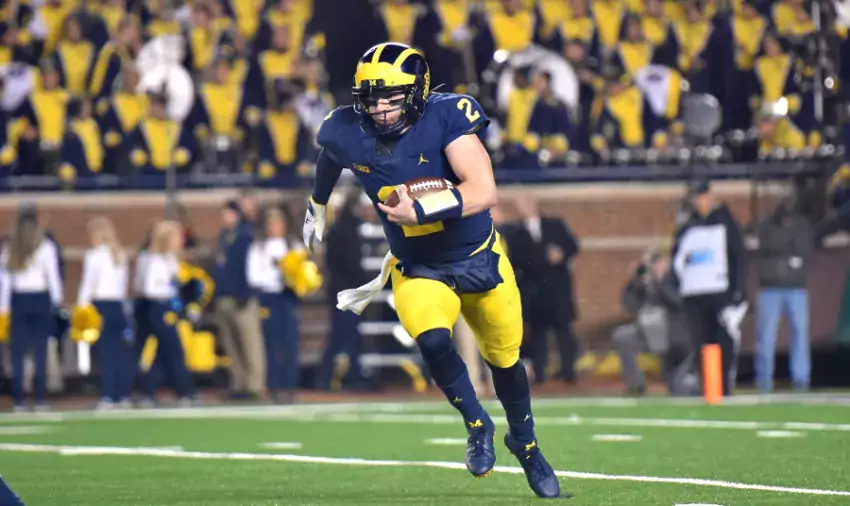
Neck Sharpies: Breaking Tendency

Michigan and Wisconsin are two of the last great bastions of Manball offense. In an age when offensive coaches are constantly trying to scheme their way to limiting the number of blocks that have to be made to win a down, the Wolverines and Badgers predicate their attacks on the concept that the more blocks they can force to happen, the more blocks the defense is going to lose. There's nothing particularly tricky about it. We are going to squeeze your defenders into a tiny, vertical space where the only directions that exist are North and South, and our heavy cavalry are charging downhill.
So of course the play of the game was a tweak to a zone-read option, a play so Rich Rodriguezian in its design you are a little bit mad at the end that the quarterback doesn't have dreads.
[Note: stephenrjking wrote a diary about this play as well]
Let's take a look at what Wisconsin thought they were defending, what they were actually defending, and how everybody's shoelaces suddenly came untied.
Ingredients:
- Zone Read
- Split Zone
- Arc Block
1. What's a Zone Read? I see you've missed the last 20 years of football. That's alright, it's a simple enough concept to explain, and a little flick of the mouse wheel if you're already up on the idea.
The zone read options an unblocked defender on the backside of an inside run play. You've seen it a thousand times. The quarterback holds the ball in the RB's hands while watching whatever defender is in that zone on the backside. If the defender forms up outside, the QB takes his hands off the ball and the RB can continue to run as if it's a normal running play. If the defender "crashes" toward the running back, the QB keeps it and runs around into the vacated space. The point is to free up a blocker by having the QB's read either hold that backside player where he can't help a run to the other side, or alternatively get that defender chasing a non-ballcarrier instead of protecting his edge. It doesn't really matter which base running play you pair it with: inside zone, power, zone stretch, Down G, whatever.
Takeaway: It's an important play because it made it possible to have a good running game from the shotgun. All defenses today know how to defend it, most commonly by having an end who finds himself unblocked "shuffle" in that purple zone to make the QB really have to think about his read, wasting precious moments while the defense is prying its way into the plausible gaps. Naturally, offenses that use the zone read have a favorite counter for this kind of thing.
2. A Split Zone. Split zone is basically just inside zone except you block the backside edge defender with an offensive player, usually a tight end, H-back, or fullback, who is blocking opposite and across the flow of the play.
A split zone run gives up some blocking on the frontside for an epic win on that backside, and is particularly punishing when that backside defender is wholly concentrated on forming up to threaten both sides of a zone read.
But again, this is a highly common play at all levels of football, so any defensive player taught to form up against a zone read is also going to keep the corner of his eye ready for any kind of trap block coming from the frontside. If one comes, he shifts his weight and meets the blocker, maintaining the edge of the defensive front and constricting space as much as possible inside of himself.
Takeaway: Any offense that runs a bit of zone read is also going to run a bit of split zone, and any player who'll be playing edge defender in a modern college defense has practiced how to convert a zone read shuffle to setting the edge against a trap block.
3. Arc Block. This is basically the opposite of a kickout block. It's usually used to describe the block by an H-back or tight end who "arcs" around a defender in an attempt to reach block him, i.e. seal him on the opposite side of where the offensive player lined up.
Takeaway: It's just a block.
[After THE JUMP: Stir with half a season of tendency and serve cold]
------------------------------------
The Setup
This play is not a base part of Michigan's offense. It's a supercounter to a base counter to a base play that they run mostly as a sideshow. The reason it broke 80 yards is not because it's some genius, unstoppable play, but because in a week of preparing for Michigan the last thing you're going to think to coach is what if they run something that spread 'n shred teams might run once in awhile to mess with how they're normally defended.
Also Michigan has had a tendency all year when they run (what looks like) zone read to not actually bother with the read—or at the very least Shea has been a super-reluctant keeper on zone reads. Here's Michigan's zone read/zone read counter game so far according to our charting:
| Opponent | ZR: Give | ZR: Keep | Split Zone | Arc Keeper | Total |
|---|---|---|---|---|---|
| Notre Dame | 7 | 1 | 1 | 9 | |
| WMU | 3 | 1 | 4 | 1 | 9 |
| SMU | 7 | 7 | |||
| Nebraska | 3 | 1 | 4 | ||
| Northwestern | 6* | 2 | 5 | 13 | |
| Maryland | 2 | 5 | 7 | ||
| Total | 28 (57%) | 4 (8%) | 15 (31%) | 2 (4%) | 49 |
* (Eubanks was arc blocking for the keeper on one of the Northwestern plays but Patterson handed it off)
Going into this game, Wisconsin's scouting told them if Michigan shows zone read action, you have an 88% chance of the ball going to the running back, either from the QB choosing to give or because they're going to slam a blocker into your formed up backside end. Sometimes he hands off even when the end is 100% in the red. Just look at some of these events from Brian's UFRs:
| Opponent | Ln | Dn | Ds | Player | Yards | Situation |
|---|---|---|---|---|---|---|
| Notre Dame | O44 | 3 | 3 | Higdon | 0 | Early 1st, down 0-7 |
| Again with the ZR that options nobody. Bad awareness on Runyan’s part as ND is creeping down a linebacker to the boundary, where there are no eligible receivers, and is absolutely going to send him. That means his guy is jumping inside. Runyan’s guy jumps inside. Runyan(-2) whiffs. But even if he does pin him inside Higdon is exposed to the LB and is hoping to break a tackle to avoid a TFL. This is dumb Hoke era read nobody stuff. RPS -2. | ||||||
| Notre Dame | M4 | 1 | 10 | Higdon | 2 | 4th Q, down 10-24, McCaffrey in |
| This is not a real read so Michigan is blocking 6 vs 7. MLB blitzes. Michigan does a pretty good job to pick him up and cover the DL slants, but Ruiz comes out on a DL and passes him off. This is correct and quick but now he resets his eyes to the overhang LB. This is the only guy he has a reasonable shot at; safety who started at 8 and is running at the LOS on the snap cuts down Higdon. RPS -2. Ruiz(+0.5), Onwenu(+0.5), Bredeson(+1). | ||||||
| WMU | M33 | 1 | 15 | Higdon | 2 | First play of the game |
| Patterson(-2) has a clear keep read with the backside end crashing and gives instead. DE doesn’t screw it up. This is a solid gain and maybe a bust right to the second level if DE shuffles, with Bredeson(+1) driving his man about two yards downfield and Ruiz(+1) finding and kicking a blitzball LB. Higdon’s about to test that gap and either Bredeson’s guy gets him or he’s to the secondary when the DE tackles. | ||||||
| SMU | M49 | 3 | 1 | Evans | 0 | Late-ish 2nd Q, tied 7-7 |
| Patterson(-3) must pull this. DE flies at Evans, TE flares to overhang LB, it will be a conversion. He does not pull. M paves a lane on the backside that Evans can’t use because of the DE. His frontside cut is futile. LB managed to get through Onwenu; Onwenu put him on the ground but he’s able to fall into Evans and grab his legs. This is a belly play on which I’m not going to ding Onwenu(+0.5). In fact he and JBB(+0.5) cave in the spot that the need to get the first down if the DE shuffles. | ||||||
| SMU | M43 | 2 | 5 | Evans | 0 | Early 2nd half, up 21-7 |
| Option nobody with just five blockers and this happens. JBB kicks a DE. Onwenu(-1) blocks down on a DT. He gets driven. Ruiz(-1) left immediately and no help for him so Evans cuts back and eats an unblocked LB. | ||||||
| SMU | O45 | 2 | 9 | Wilson | 7 | ^same drive, 4 plays later |
| Onwenu(+2) ejects the NT from the premises. MLB doesn’t fall for the zone action and cuts behind Ruiz’s block; Ruiz is able to shove him into McKeon(+1) and his guy and he goes down. Wilson(+0.5) finds the gap; JBB(+0.5) had a solid kickout. | ||||||
| Nebraska | M28 | 2 | 5 | Wilson | 4 | Late 2nd, up 37-0 |
| M lets a DE through free. He charges at the mesh point. Patterson gives. Is that a real read? Dunno. If it is this is a midline zone read that worked very well except for Wangler blocking the guy who they optioned and leaving the MLB untouched. If it is not then this is a trap play that has no one to account for the MLB. Going with the former. Wangler -2. Anyway Wilson(+2) does really well to spin off two tackles including the very unblocked MLB and grind out a good gain. | ||||||
| Northwestern | M37 | 1 | 10 | Higdon | 2 | Early 4th, down 13-17 |
| Another read nobody play. As soon as Gentry blocks instead of releasing the OLB over him fills on the running back and tackles unblocked and un-optioned. RPS -1. | ||||||
| Northwestern | O28 | 1 | 10 | Higdon | 1 | Late-ish 4th, down 13-17 |
| 7 man box but a corner blitz to make it eight. DT slides to Onwenu; JBB releases to LB level and has no angle. Onwenu(-1) driven into the backfield. Runyan(-2) gets ripped through pretty badly and that guy tackles at the LOS. No read, FWIW. | ||||||
| Northwestern | M41 | 3 | 5 | Higdon | 4 | Late 4th, up 20-17 |
| A must pull from Patterson(-2), who has absolutely nobody bothering with him on the edge. Handoff, possibly called Higdon(+1) cuts back to the giant acres of space Patterson spurned but can’t quite get there. Gentry(-1) got blown back by the Gaz. Can’t blame him but that’s a minus. | ||||||
| Maryland | O45 | 3 | 3 | Higdon | 0 | 3rd play of the game |
| Patterson(-2) has to pull this and does not. Backside end crashes and TFLs. JBB(+1) and Ruiz(+1) both took and moved their guys, FWIW. | ||||||
We've all got our theories as to why Michigan is either running fake reads from the Hoke offense or just has their keep slider set to Breaking Madden levels (mine is they hope to get their starting quarterback to the OSU game healthy for a 3rd time this century). The point is that opponents are seeing things like this:
…and picking up on the tendency.
Now, Michigan has shown the arc read before. They've run it three times in fact: once against ND, one against WMU in garbage time, and a third against Northwestern where Patterson handed it off correctly. The other two were with McCaffrey. So if you're preparing your defense for Michigan, an arc read keeper is hardly a top priority, especially since you only have a whiff of it—which well might have been just a fake—one time when Patterson's in.
If you're Jim Leonhard, and playing the numbers with limited practice time and limited head space for a bunch of first-year edge players, do you even bring up the arc, or do you take that 88% bet that crashing your DE against any kind of zone read action will get you a cleverer-than-Harbaugh moment or three? Why not crash and live with the consequences. It's not like Michigan has Denard back there.
The Play
It's the first play of the 2nd quarter after Wisconsin just punted Michigan back to its own 14 yard line in what's so far been a 0-0 slobberknocker of a game, so you might expect a little more 4-yards-and-a-cloud-of-dust here than usual. Michigan's in a pistol with an extra tight end on the line instead of a third receiver, but everything else is pretty standard for that ever-popular pistol zone-read offense. Everything here says Michigan's running a pretty standard play up the gut, perhaps with that crazy-conservative fake option. They're not.
It's called an Arc Read.
The base concept is Rich Rodriguez's zone read, even complete with a little WR screen pre-snap read if the defense is short of manpower out there. The tweak is what happens with the H-back's block. To feel it happen let's live it from Wisconsin's view.
At the snap, the End Man on the Line of Scrimmage (EMLOS) is the weakside linebacker, Zach Baun, from Brown Deer, Wisconsin. He's a redshirt junior, having sat out 2015 to learn linebacking after playing quarterback for his high school. He also missed last year for a foot injury. He's no rube: he's Academic All-Big Ten, and he's played in 18 games, starting 6, in the 21st century. The man knows when he's in Rich-Rodville.
The quarterback is turned his direction and looking at him. He's being optioned, or they want Baun to think he's being optioned. He checks for crossers, and sure enough, there's McKeon. Baun's already shuffled to the redder part of the zone read because of Michigan's history. Now he's seeing that crosser and thinking it's probably split zone. Time to form up and let this tight end feel the weight of four years in Cheese and Bratwurst Country, right?
Right?
Haha, foiled, you silly tight end. I am inside you and your running back is…wait whereareyougoing?
McKeon: Call it a….
Wildgoose chase.
So that takes care of the edge: faking the DE into using himself up on Chris Evans wins Michigan a McKeon block vs a true freshman cornerback. But we've still got a free linebacker whom Gentry couldn't seal inside, and that guy is Ryan Connelly, an all-conference type.
I've watched Wisconsin defend spread 'n shred offenses before and one thing they often do (and Michigan does too), and what I think they're doing here is exchanging gaps on the fly between their EMLOS and the linebacker behind. When Baun dives inside, Connelly is supposed to see this and take Baun's old (D) gap, since Baun's now effectively in Connelly's C-gap.
Defenses will call something like that on purpose all the time—it's called a Scrape Exchange—and Iowa used that strategy to end Michigan's tinkering with zone read games with the Pepcat package in 2016:
this is that band "Bear vs Shark" I mentioned in the podcast on Friday FYI. @Brian it was also a book, not a blog
When you do it on the fly, however, it's just a gap exchange. The Iowa play is designed to destroy a zone read, having the end crash (not read or look for crossers) and the LB replacing him hunt down the resulting keeper. What Wisconsin did with Connelly and Baun was have them read and react to each other. The difference is subtle, but al the difference on this play, because Gentry had a shot to seal Connelly off his release. Watch Gentry (#83, the TE on the top of the line), and Connelly (#43, the top ILB) on that replay cut:
It's one thing to get a DE crashing, especially when he sees split zone action. It's quite another to get the guy who's supposed to make the crashing guy right act so wrong. Connelly has no respect for the keeper when he jump-cuts past Gentry then crashes inside as well.
Why's he doing that? Because he thinks it's split zone too. Gentry's behavior—doubling that playside "DE" (I still want to call him a DT) to widen the gap—would be pretty normal for split zone. I mean he really kicked that DE (DT)'s ass. If it was split zone, and if McKeon's would-be block opened the other side of the gap, the walloping Gentry (and Runyan) gave that poor kid would create a lot of space for the back to cut downhill.
There wouldn't be much of a gap with Baun crashing and shouldering inside the H-back, and Connelly should ken that. But he's playing the odds: Michigan ran more split zone than zone read the last two weeks, and when Michigan looks like they're running zone read they might not even be reading anybody. Arc keeper? Pfaw. I'll believe it when they break tendency—and no, doing it with McCaffrey's kid doesn't count.
What We've Learned
Michigan probably isn't going to get to surprise anyone by keeping it again, and doesn't face another cornerback as unready to play as Rashad Wildgoose all season (Rutger has some cornerbacks—it's just everywhere else they're terrible). But there's a great benefit to making the defense play you as if the quarterback might keep it. They can't rush their defensive ends upfield, or crash multiple guy inside on your handoffs. Those actual split zones will have a lot more room to operate against shuffling ends, and the ends that shuffle will have to learn not to favor the handoff so much.
If indeed escorting Shea intact to this part of the schedule was the goal, that's accomplished. Michigan's next two opponents are both typically strong at defending QB rushing attacks with their base Quarters defenses, but that strength comes from walking down their safeties, a dangerous prospect when facing a strong vertical passing game and a quarterback you have to keep contained. Not only did Michigan get an important 81 yards to flip the course of this game for good: they've shown they're willing to make you defend all 11 guys on the field in their running game. No more odds. No more free RPS. If you're going to shut down Michigan's offense from here, you're going to have to win your own battles. The cavalry's come. LFG.
October 16th, 2018 at 10:26 AM ^
Great article. I'd make a minor nitpick to your diagram, I'm pretty sure the FS actually wanders towards the LOS and to his left which takes him waaaay out of the play and makes this an 80 yard run instead of a 30-40 yard run.
October 16th, 2018 at 10:34 AM ^
He's definitely out of the play. It's impossible to tell what he's responding to from the camera angles we have available, but he starts high to the wrong side of the play and has both a basic inside run action and WR screen action to respond to. He obviously bites on at least one of those.
October 16th, 2018 at 11:32 AM ^
This is accurate. McKeon does a great job of initially picking up the block of the FS but for some reason decides to stop being a blocker in lieu of sprinting escort. At about the michigan 25 yard line, McKeon is in the perfect position to block #5 into #43 at which point Shea scores with no one close. McKeon's decision instead to drop the block and then try to resume blocking downfield when it's too late is slightly frustrating to watch. He manages to stop the slower 43 but the speedy FS makes the play.
October 16th, 2018 at 11:49 AM ^
Uh
So, first of all, the guy that Mckeon blocks is a corner, not the free safety. The FS is never in the picture. And he blocks the corner really well. And then he gets down field and executes a brilliant block to snuff out the closest chaser.
If you watch this play and get frustrated at Mckeon, who makes two fantastic blocks here including one waaaaay downfield, because he lacks eyes in the back of his head, I don't know what to tell you. You can't ask a guy to do a better job than that.
October 16th, 2018 at 11:53 AM ^
No, it's not the FS that makes the play. It's the CB #5 originally blocked by McKeon that gets back into the play. That FS is totally lost. Stare at the middle of the field on the replay. You'll see that he's still facing the line of scrimmage when one of his teammates is starting to pass him to chase Patterson. I'm sure when Leonard prepares the film session he'll be muttering to himself "learning opportunity, learning opportunity" because if that guy had any experience you'd be screaming at him, "WTF are you looking at? You gotta have broader vision than tunneling into the tunnel."
October 16th, 2018 at 2:18 PM ^
I had a bit that I deleted because the article was getting long about what happened with the FS, but since my bit was about breaking tendency and that was just a dumbass play by a terrible safety I didn't feel the need to belabor it.
October 16th, 2018 at 7:39 PM ^
Fair enough. I’m not sure if the screen action or the fake to Evans got him or both. Looked to me if he had done nothing at all for the first 3 seconds of the play he’s probably getting Shea at the 50 or so.
October 16th, 2018 at 10:30 AM ^
I think the arc block is a read itself by the H-back rather than a set call. If the EMLOS crashes arc around and seal. If he shuffles wham him to open up backside gap.
October 16th, 2018 at 12:33 PM ^
Teams can do either. I’m almost certain this is not a read by the H back though. Michigan doesn’t rep it enough to warrant the cost of implementing and runs split zone regardless of EMOL response to make me think they’re reading it
October 16th, 2018 at 10:34 AM ^
Stoked for gritty, gutty, gym rat, lunch pail, non-dread qb keeper!
October 16th, 2018 at 11:40 AM ^
Especially with our sneaky athletic QB(s)
October 16th, 2018 at 10:34 AM ^
Good stuff, Seth.
October 16th, 2018 at 10:37 AM ^
Potential to make this into a true RPO? If the defense recognizes and the CB tries to get around the arc blocked, couldn't McKeon keep going into a route and be wide open? We'd just have to make sure nobody is blocking downfield...
October 16th, 2018 at 10:42 AM ^
That would certainly be an interesting wrinkle.
The only person near 3 yards downfield around the point at which McKeon could become a receiver is Gentry and everyone else is in a muck in the middle. Could certainly clean that up a bit so he doesn't go too far and allows Shea to have the pass as an option still.
October 16th, 2018 at 10:56 AM ^
Mckeon isn't in the right position for an option. But they are running RPO action on the right side. Shea isn't facing the correct direction to exploit it, but a tweak here and there and it's available.
October 16th, 2018 at 11:20 AM ^
That was my thought as well when seeing the replays of that. And if Shea rolls left and the line stays within 3 yards it could suck a lot of the defense down in front of the TE.
October 16th, 2018 at 11:26 AM ^
I like it.
TE could just run to the flat. If LB runs with TE, QB runs. If LB attacks QB, easy throw to uncovered TE. This could be the 2018 version of "QB Oh Noes."
October 16th, 2018 at 11:43 AM ^
The RPO version of this is really with the arc blocker, not the Y-TE.
Rather than arc up, the TE simply runs to the flat once he by-passes the DE. "Slide" RPO is what a lot of teams call it. OSU and PSU both run a version of it. I talked about it at the end of this post: LINK
October 16th, 2018 at 12:11 PM ^
Why into the flat and not downfield? Making the route go into the flat seems to limit the upside of the play. If McKeon turns that route downfield, he is either open for a little lob pass with his momentum going downfield, or the CB runs with him and it opens up the run for Shea.
October 16th, 2018 at 12:38 PM ^
Because it takes time to get the H across the formation and into a route. So the flat allows 1) for it to be quick; 2) a clear read to the conflicted defender; 3) actually behind the LOS so they don’t have to worry about illegal downfield.
They could do what you’re asking, but I think it would be better as a true play action pass than an RPO, which I think would be expensive to implement because of what you’re asking from your OL compare to how they’d traditionally block this run play
October 16th, 2018 at 1:39 PM ^
Space Coyote answered most of the points but a subtle one is the DOD of the throw. If McKeon goes to the flat, Patterson shoulders are nicely squareded up to make an easy throw. If McKeon turns up field, then Patterson has the turn his shoulders more to make the throw as well as exposing himself if the defender decides to go all out on the QB.
Very little extra benefit by turning the route up field. Everything is already accomplished with the flat route. TE, open field, night one within 20 yards of him.
October 17th, 2018 at 10:16 AM ^
Moreover, you have to expect sound football from the FS. If you try to lob one over LB to the H running vertical, the FS can defend that.
October 17th, 2018 at 10:13 AM ^
Yes, sorry, the H (McKeon) is who I meant.
October 16th, 2018 at 10:43 AM ^
"Let's take a look at how what Wisconsin thought they were defending, and everybody's shoelaces suddenly came untied."
I just want to say I like your writing style man.
I do think that Shea and the Michigan QBs need to continue to work on selling their fakes on every play. Shea has been very good at this IMO. And he was masterful at this while at Ole Miss, selling hand off fakes on zone read plays, shifting his entire body to align with his shoulders on RPOs, etc. Crisp stuff.
It makes a difference for every play, because we know that some blocks take time to connect, set and sustain. And every second of potential defender hesitation restricting their momentum and power buys blockers more time to set their blocks and gain leverage, and every second affords runners more time to generate inertia and escape routes.
October 16th, 2018 at 11:12 AM ^
In the SMU clip, the little hop thing Shea does at the end of the play comes off to me as "Man I wish I was allowed to have pulled that" rather than "Man I should've pulled that".
Michigan has done a great job of keeping a counter in their back pocket for when they need it. And by the time we get to PSU and OSU, there will be 7 or 8 options the defense has to prepare and be read after the snap. When they can't commit to your tendencies, they have to hesitate, and that's when you can start getting 5+ yards consistently on the base play again.
October 16th, 2018 at 10:49 AM ^
"So that takes care of the edge: faking the DE into using himself up on Chris Evans wins Michigan a McKeon block vs a true freshman cornerback."
Unless the refs call Evans for "holding" the DE.
October 16th, 2018 at 10:56 AM ^
According to Shea this play is courtesy of Ed Warinner.
October 16th, 2018 at 12:26 PM ^
Maybe it's not so bad to have multiple minds with input into the offensive playcalling? Who would have thought
October 16th, 2018 at 3:57 PM ^
"Good shit, Ed"
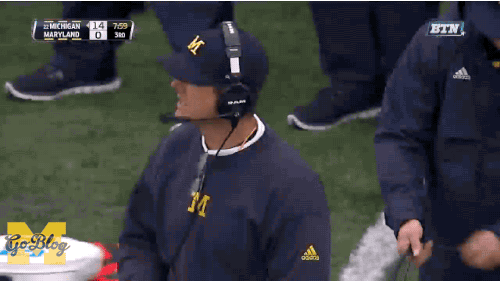
October 16th, 2018 at 11:04 AM ^
How does this play compare to the Karan Higdon "holding from Mars" play against Northwestern?
October 16th, 2018 at 11:29 AM ^
Good stuff here.
A few other things I noted it in my own article on the same play, but I think are important nuances as well:
1) They ran this arc block out of pistol, which I don't think they had shown this year (but as you noted, they had shown previously with Peppers). Before, it was all split zone or some form of stretch/pin and pull/down G action from pistol
2) The formation helps this play out a lot
3) This play wasn't even blocked great as the TE/OT combo that downblocks the DE into oblivion never comes off onto the ILB that it should be blocking despite the gap exchange. Still works because, as you noted, everyone is expecting split zone because that's what Michigan does.
As I also noted in my post, as soon as Michigan ran this, that split zone action became a lot more effective too, as the DE started staying out wide. It's really a great additional wrinkle for them to have in the bag.
October 16th, 2018 at 11:31 AM ^
Great article Seth - thanks for the effort
October 16th, 2018 at 11:40 AM ^
Great post - thanks Seth. I really enjoy the Neck Sharpies series, and this one is my favorite so far. I hope next week you get to write about another satisfying wrinkle from the coaching staff.
October 16th, 2018 at 12:15 PM ^
What has been impressive with Shea and the backs this year is they are selling all of their fakes. One of my greatest frustrations is offensive players that half ass their fakes
Our guys have been selling it all this year. It’s smart play and good coaching.
Also note the safety fly up....we can go over the top with this play.
October 16th, 2018 at 12:47 PM ^
Selling fakes so hard that our RBs get tackled... and then get called for holding somehow
October 16th, 2018 at 12:23 PM ^
Great article! In particular, I like the screen shots with the arrows. Really cool. I am sure this took a long time to do but I would love to see more of it.
October 16th, 2018 at 12:23 PM ^
This is so great Seth, thank you
Is there a pass play that runs off of this?
October 16th, 2018 at 1:37 PM ^
Michigan already utilizes split flow looks to generate a lot of their play action pass offense.
As noted above in the RPO discussion, you could turn this into a wheel route to get a true "arc block" play action pass.
This play (along with the split flow) is a lot like what we saw OSU take to a national championship in 2014. What I'd like to see Michigan adapt is the quick attacking vertical routes that OSU utilized as part of that package. UM uses the longer developing pass concepts well out of play action here, but attacking the seams quickly would add to the difference in timing the defense has to face.
I wrote about the concept OSU leaned on here: LINK
October 16th, 2018 at 1:57 PM ^
I think these add-ins are coming down the line. Coach Ed's wrinkles are now showing up in the offense. And he has the OL ready to handle more.
October 16th, 2018 at 2:02 PM ^
That's fantastic, thank you.
I follow you on twitter, and if I can offer a bit of a critique - if you can go back to basics continually with your discussion, it's helpful to us newbies who want to learn. Didn't study it, don't have the basics down, so if you can keep re-treading the basics as you explain the concepts, it's really helpful.
October 16th, 2018 at 2:49 PM ^
Good comment and I appreciate it. It is sometimes hard with the character limits on twitter to get back to basics (and I get into enough "twitter threads" because of a lack of effort in staying succinct anyway), but it is a good reminder that sometimes you need to return to basics. I try to make sure in my actual blog posts that I link back to basics, but even there I think I need to spend some time in the off season re-creating some content that helps set a stronger foundation (which was part of the intent of my blog to begin with).
October 16th, 2018 at 1:30 PM ^
"Wildgoose chase" was amazing
October 16th, 2018 at 1:41 PM ^
I hope coaches realize that sparty is gonna try to take out Patterson on the zone read .It's their best chance to win game. Not only tricks but dirty tricks.
October 16th, 2018 at 6:51 PM ^
Ugh so true. McCaffrey can win this game too, fortunately. But it's sickening to think about.
October 16th, 2018 at 1:53 PM ^
Arc keeper, for sure. This play was set-up by all of the split zone on film and the way the blocking was designed (especially Gentry) was pure deception. Harbaugh was betting they bite hard on that 88% tendency. Great call and nice ball handling by Shea ... and Evans who strongly sold the fake.
Timely deception with high level execution ... awesome.
October 16th, 2018 at 2:11 PM ^
The cavalry’s come, indeed. Folks have been critical of the play-calling the past few years, but clearly the problem wasn’t the offensive thinking, it was that they didn’t have the horses to run the plays Harbaugh likes to see run.
Warriner was a great hire. Patterson was a great get. They finally have what they need to run a more diverse offense, and the result is a more impressive, legit offense.
It’s an understatement to say the team is more balanced this year. They’re also playing with greater confidence each week - anyone can see it. Looking ahead to MSU: Harbaugh now has more firepower than Penn State had on Saturday. There’s a better defense than PSU to compliment the firepower.
As good as MSU’s defensive stats are against the run, they might be skewed by the competition. Consider who they’ve played: Indiana, Central Michigan, Arizona State, and Penn State. Show me a team with a dominating run game in that group, besides possibly/maybe Penn State. Michigan has a better run game than Penn State - over 100 yards more on the ground than Penn State this year. And Penn State ran for over 200 yards against Sparty, which I think was about double what MSU has allowed on the ground so far.
In other words, show Sparty a diverse offense with a good running attack, and the numbers change. On the other hand, we’ve faced some pretty good run-oriented teams in Maryland and Wisconsin, and our defense has delivered the goods. We’ve also been good against the pass - did I read that we’re #1 in the country in that stat?
So, force a team like MSU to become one-dimensional, pressure Lewerke as we did with Hornibrook, and it could be a long day for Sparty. Their defense isn’t what it’s cracked up to be.
I think we have a good shot at running the rest of the table this year. PSU and MSU don’t appear to be as daunting, and OSU is vulnerable, though they have an awesome QB.
October 16th, 2018 at 2:29 PM ^
Seth,
As always, thanks for these posts. They are great.
October 16th, 2018 at 3:07 PM ^
Best Neck Sharpies yet...
Bullit points, charts, UFR’s, GIF’s, graphics, screenshots, & video - Wow!
Bravo!
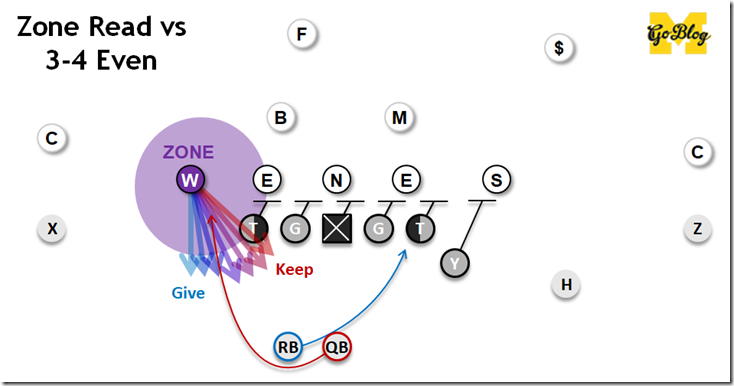
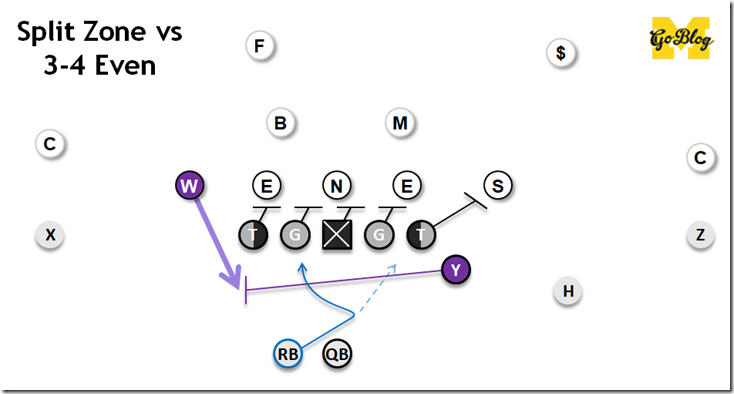
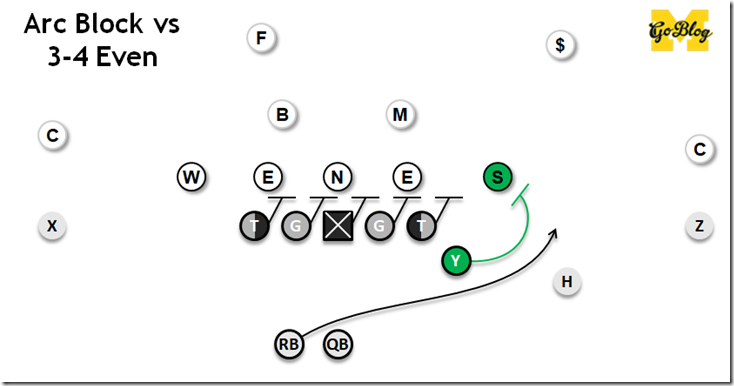
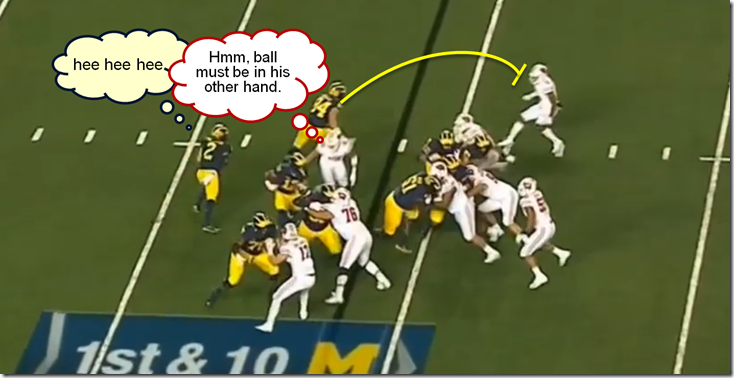
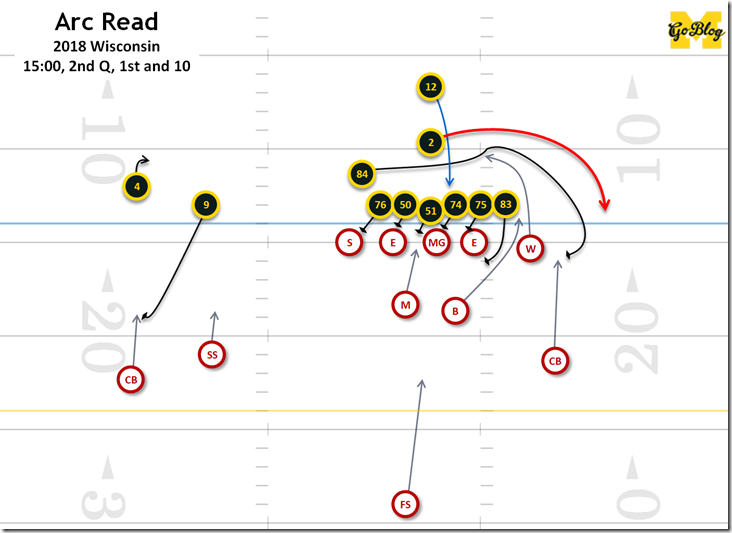
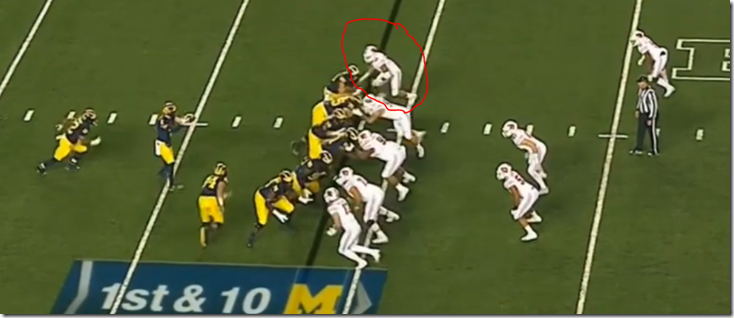
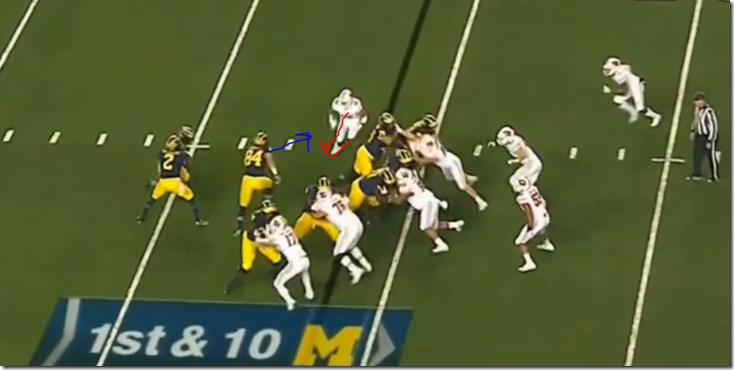
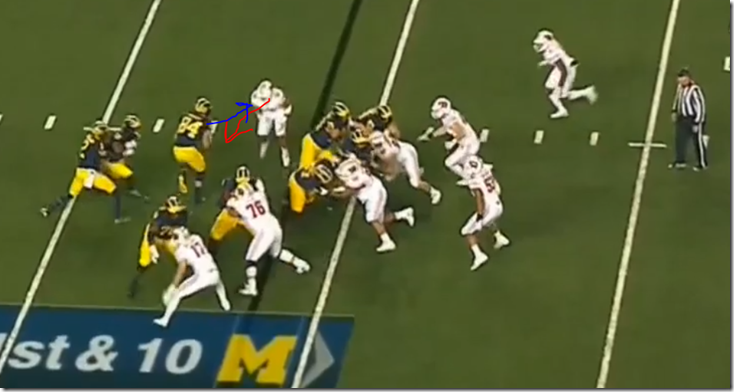
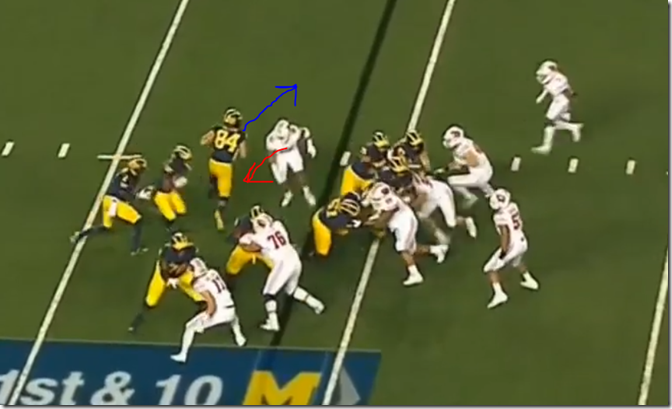
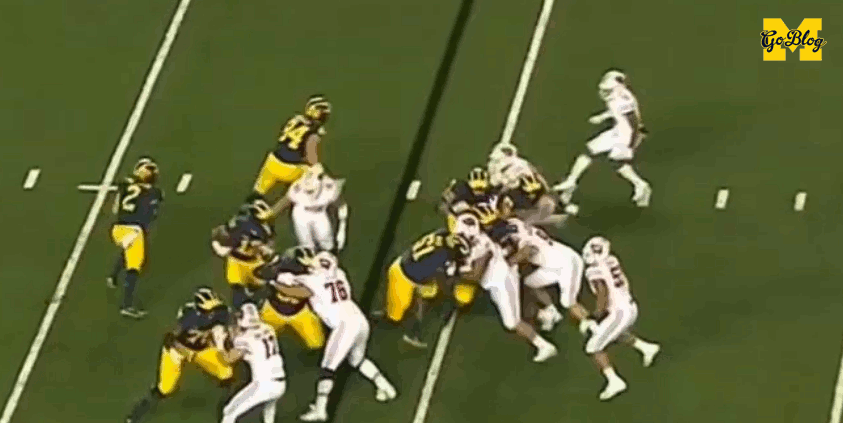
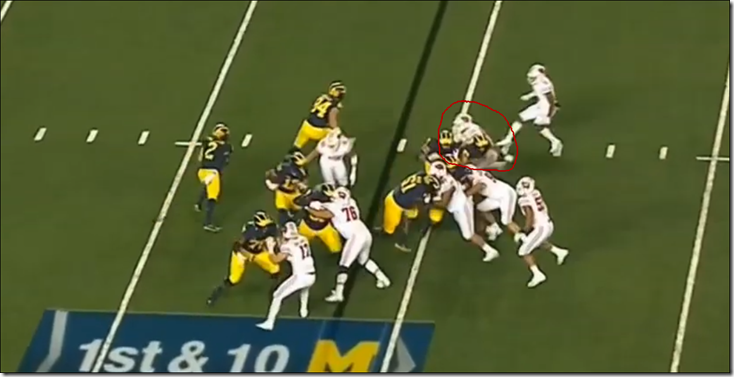

Comments